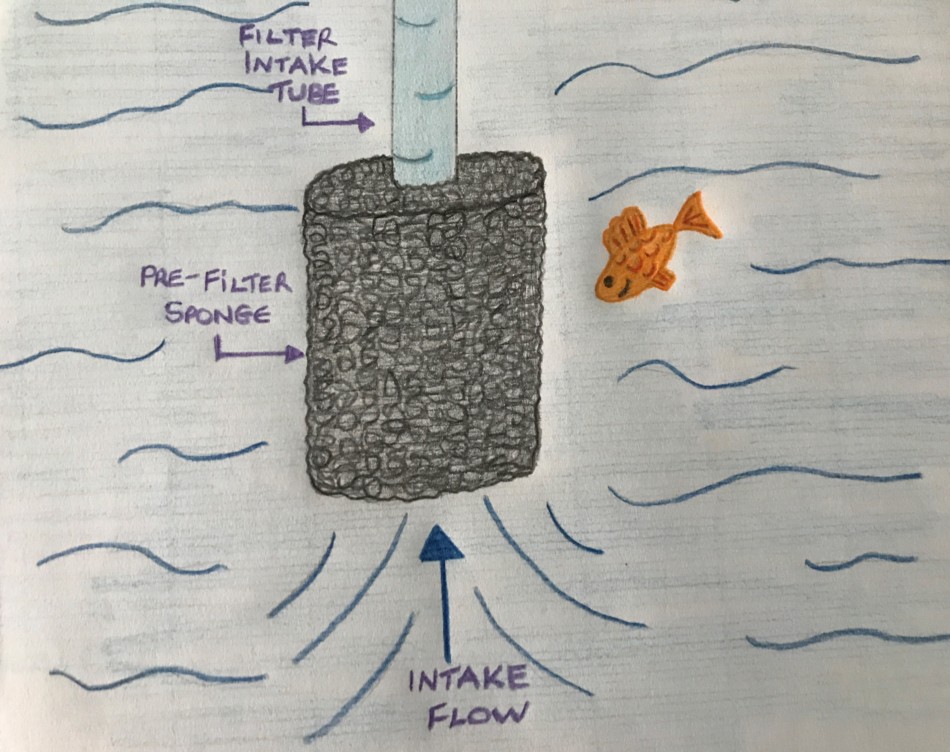This article may contain some affiliate links to products. The links provide me a small percentage of commission but do not cost you anything extra to use. (See full disclosure statement here ).
).
Pre-filter sponges are a simple and cheap way to increase the filtration in your aquarium. They not only help your filtration system to be more efficient they also have several other benefits too.
A pre-filter sponge is a sponge that covers the water intake part of your filtration system. Although often black in colour, and cylindrical in shape, this can vary depending on the type of water intake you have on your filter. The purpose of a pre-filter sponge is to aid filtration and prevent baby fish, shrimp and snails etc being sucked into the filter mechanism. It also stops larger pieces of tank debris being sucked into the filter motor, which reduces the risk of damage.
Let’s take a more detailed look at what pre-filter sponges do and whether you need one
How Does A Pre-Filter Sponge Work?
A pre-filter sponge works by adding an extra filtration layer to the intake of your filter. The sponge allows water to flow through to the filter mechanism in the usual way so it doesn’t restrict flow. As the tank water passes through the pre-filter sponge the sponge catches debris from the water. And because it’s a simple sponge cover it doesn’t need to be powered independently in any way.
Tip: It’s better, in general, to use a coarse sponge as a pre-filter sponge. A coarser sponge catches larger pieces of debris and takes longer to clog up which means you need to clean it less often.
What Does A Pre-Filter Sponge Do?
A pre-filter sponge is useful in an aquarium/tank in many ways. But what exactly are its uses?
Here’s some stuff that a pre-filter sponge does:
- Catches larger pieces of tank debris and stops them from entering the filter motor
- Increases the amount of mechanical filtration
- Helps to keep the water cleaner for longer because it acts as a secondary filter
- Reduces how often you’ll need to clean the main filter sponge/media
- Prevents small fish, shrimp and snails etc from being sucked into the filter
- Provides extra surface area for beneficial bacteria to grown on
- Adds another area for fish and shrimp to feed off
As you can see from the list above using a pre-filter sponge has many benefits. Even if you’re not keeping small fish, shrimp and/or snails in your aquarium you will still benefit from using a pre-filter sponge on your filter intake.
Tip: If your fish, shrimp and/or snails are likely to breed, or you’re planning to breed them, a pre-filter sponge will help to cut down losses to the filter mechanism/motor.
How Do I Clean A Pre-Filter Sponge?
Cleaning a Pre-filter sponge is easy. Turn the filter power off. Remove the pre-filter sponge from the water intake part of your filter. Rinse the sponge out in used tank water before replacing it. Turn the power back on again.
It’s as easy as that!
Using tank water to rinse out the sponge helps to keep the beneficial bacteria alive. However, some fish keepers rinse the sponge out in tap water because it’s not the main filtration sponge/media. It’s up to you how you prefer to rinse out the sponge, just use your own judgement.
Tip: Using a pre-filter sponge helps to stop fish food being sucked straight into the filter. The trapped food will be eaten by your fish, shrimp and snails later. This means that food waste is reduced and in turn will save you money.
Do I Need A Pre-Filter Sponge?
A pre-filter sponge is a great addition to most aquariums. Whether you choose to add one or not is up to you. But taking a look at what a pre-filter sponge can do for your tank, at little expense and minimum effort, might help you to decide. So take another look at the sections above to help with your decision.
There are many different types of pre-filter sponge (Amazon link) available. Choose the shape and size that you need for your tank size and filter intake.
(Amazon link) available. Choose the shape and size that you need for your tank size and filter intake.
Tip: Remember that a pre-filter sponge only needs an opening at the end where you attach it to the intake tube. The other end should be closed or the water will not be filtered before it enters the tube and main filter mechanism.

